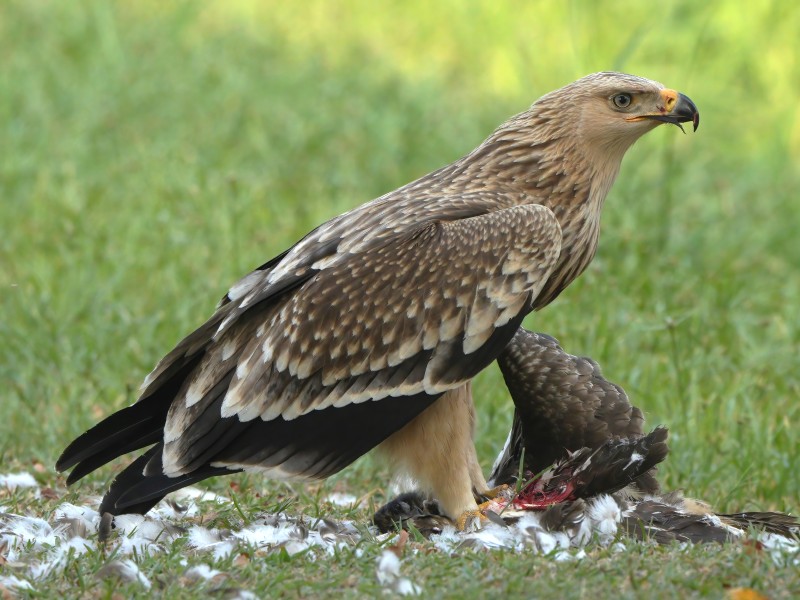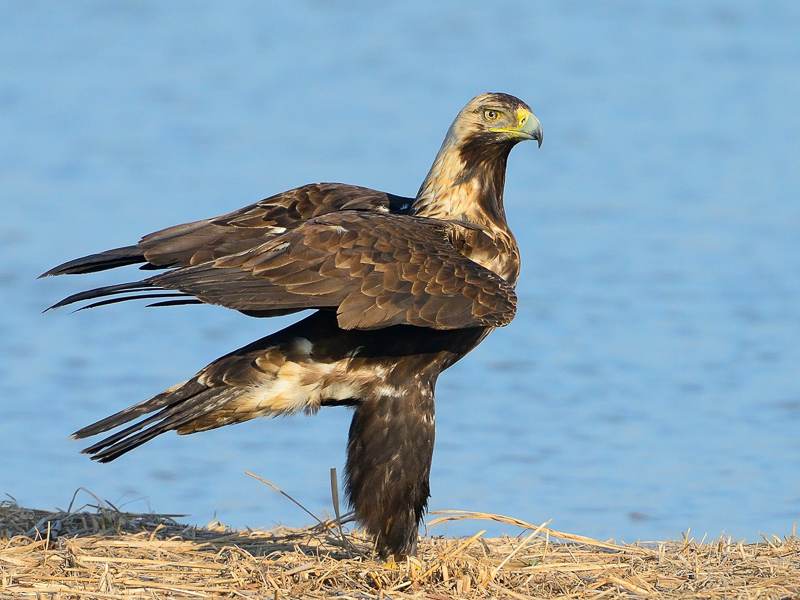Eastern Imperial Eagle Aquila heliaca 白肩鵰
Category I. Scarce winter visitor to Deep Bay area.
IDENTIFICATION

Jan. 2020, John and Jemi Holmes. First-winter.
72-84 cm. Less compact and slightly larger than Greater Spotted Eagle with slightly longer wings and tail, the latter with more pointed corners. Head and bill rather large. Soars and glides on flat or slightly upturned wings. Paler inner primaries in immatures.

Nov. 2024, Paul Leader. First-winter.
Compared to Greater Spotted Eagle, gape not as obvious, legs more feathered and nostrils oval. In first-winter plumage feathers are uniformly worn

Nov. 2013, Kinni Ho. Adult.
Adults are dark above with a pale buff shawl on head and 2-3 white scapulars forming two patches on the upperparts. Tail greyish with narrow barring and broad tail band, both indistinct.
From second winter pale wing and tail feather tips lost or less obvious and dark feathers on upperparts increase in extent.
VOCALISATIONS
Not known to vocalise in HK.
DISTRIBUTION & HABITAT PREFERENCE
Most records are from marshes, fish ponds and adjacent hillsides in the Deep Bay area, but birds are occasionally also sighted in other parts of the northern, central and northeast New Territories at such places as Long Valley, Ping Che and Lam Tsuen.
Both Eastern Imperial and Greater Spotted Eagles appear to roost in forest areas of Tai Lam Chung, and birds are seen in flight to and from there evening and early morning.
OCCURRENCE
Most records of occur from November to the first half March (Figure 1), with extreme dates since 1999 of 18 October and 6 April. The apparent peak in late November and early December may refer to the occurrence of passage birds, but this is by no means certain. The wintering population appears to remain unchanged until mid-February, after which there is a gradual decline to the first week of April.
All reports since 1999 are of one to five birds, though the latter count was only made twice in the period. In contrast, in the 1990s ten or more, mainly birds loafing at Hoo Hok Wai, were recorded on seven dates, including 14 on 13 December 1996 and 11 January 1997 and, exceptionally, 21 moving east over Mai Po during 90 minutes on 27 February 1993.
Eastern Imperial Eagle was regularly reported after 1959 when the first one was noted at Ping Shan on 11 January. The peak count rose to three in 1967-68, four in 1972-73, nine in 1980-81 and, excluding the count of presumed passage birds above, 14 during 1996-97. At the end of the 1990s Eastern Imperial Eagle was twice as numerous as Greater Spotted Eagle; while it remains more numerous, the difference is now much smaller. Further evidence of a decline is provided in Figure 2, which illustrates the peak aggregate weekly counts per winter period at Mai Po NR since 1984/85 and indicates that numbers now present may be only 50% of the levels recorded in the mid-1990s.
While the increase after 1980-81 is thought to be mainly attributable to better reporting, the increase prior to 1980-81 seems likely to be related to other factors, probably changes in land use. According to Wong (1986), the percentage of agricultural land in HK given over to fish or duck ponds increased from 1.4% in 1954 to 6.8% in 1969 and 18.2% in 1979. The proportion of such land was almost certainly higher in the Deep Bay area. It seems possible that an increase in the number of domestic duck ponds, and the resultant rise in the number of sick or injured individuals, would sustain larger numbers of eagles in the Deep Bay area. At Hoo Hok Wai, in particular, there was a high number of duck ponds, and it was from here that the highest counts were recorded in the 1990s. Duck farming declined considerably in the 1990s, and since 1999 no more than two birds have been reported from Hoo Hok Wai, and most of these were up to winter 2005/06.
In seven of the years from 1980 to 1996 there were reports of birds in the first half of April, the latest on the 17th in 1994. In addition, in five of the years from 1986 to 1991 there were several reports of birds in the second half of September and first half of October, the earliest of which occurred on the 18th. The contraction of the period of occurrence may be related to the decline in numbers that has occurred overall. However, it may also be due to confusion with Bonelli’s Eagle, juveniles of which were regularly, if not frequently, seen in the Deep Bay area post-breeding. It is noticeable that since Bonelli’s became very scarce in HK, early autumn reports of Imperial Eagle have ceased.
BEHAVIOUR, FORAGING & DIET
Apart from a Grey Heron at Mai Po on which an adult was feeding (Tipper 1992), Pied Avocet and a Black Kite that appeared to have been predated by the eagle, the only other observation of predation refers to wild and domestic ducks, a prey item also noted in Fujian by La Touche (1931-34).
Generally solitary. Birds can be seen roosting on trees in the southern part of Mai Po NR, especially in the afternoon before flying to night roost in Tai Lam Country Park.
RANGE & SYSTEMATICS
Monotypic. Breeds from southeast Europe east through western Russia, southern Siberia, Mongolia, northern Kazakhstan, northwest and northeast China; winters south of the Black and Caspian Seas, the Middle East, locally in east Africa, northern parts of the Indian subcontinent central, east and south China and Indochina (Meyburg and Kirwan 2020). In China summer visitor to northwest and winter visitor or migrant to areas south of a line from southern Tibet to Hebei (Liu and Chen 2020).
CONSERVATION STATUS
IUCN: VULNERABLE. Population size 2,500 to 9,999 birds and declining due to habitat loss and degradation and adult mortality via persecution and collision with power lines, nest robbing and prey depletion.
Figure 1.

Figure 2.

La Touche, J. D. D. (1931-34). Handbook of the birds of Eastern China Vol. 2. Taylor and Francis, London.
Liu, Y. and Y. H. Chen (eds) (2020). The CNG Field Guide to the Birds of China (in Chinese). Hunan Science and Technology Publication House, Changsha.
Meyburg, B.-U. and G. M. Kirwan (2020). Imperial Eagle (Aquila heliaca), version 1.0. In Birds of the World (J. del Hoyo, A. Elliott, J. Sargatal, D. A. Christie, and E. de Juana, Editors). Cornell Lab of Ornithology, Ithaca, NY, USA. https://doi.org/10.2173/bow.impeag1.01
Tipper, R. P. (1992). Spotted Eagle scavenging on prey of Imperial Eagle. Hong Kong Bird Report 1991: 195-196.
Wong, C. T. (1996). Land Use in Agriculture. In Chiu, T. N. and C. L. So (eds). A Geography of Hong Kong 2nd ed., Oxford University Press, Hong Kong.

